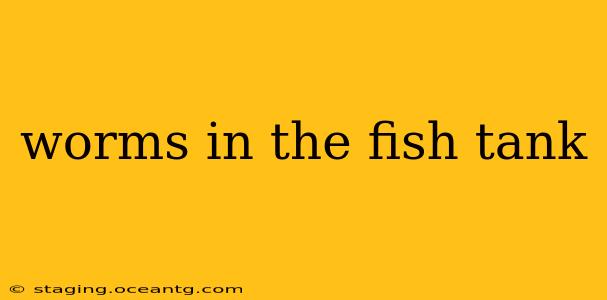Discovering worms in your fish tank can be alarming, but understanding the type of worm and its cause is the first step to resolving the issue. This comprehensive guide will help you identify common aquarium worms, understand their origins, and implement effective prevention and treatment strategies to maintain a healthy and thriving fish tank environment.
What Kinds of Worms Are Commonly Found in Fish Tanks?
Several types of worms can infest fish tanks. The most common include:
-
Planaria: These flatworms are usually small and light-colored. They're often found scavenging on decaying organic matter. While generally not directly harmful to fish, large infestations can indicate poor water quality.
-
Nematodes: These roundworms are microscopic and can be difficult to spot without a microscope. They often live in the substrate and can parasitize fish, causing health problems.
-
Tubifex worms: These are reddish-brown worms that live in the substrate and feed on decaying organic matter. They're often considered an indicator of poor water quality, but they aren't directly harmful to fish unless present in massive numbers.
-
Annelid worms (various species): This broad category encompasses many segmented worms, some beneficial and some potentially harmful. Identifying the specific species is crucial for determining the appropriate course of action.
How Do Worms Get into My Fish Tank?
Worms can enter your fish tank through several pathways:
-
Infected fish: Introducing new fish without proper quarantine can introduce parasites and worms.
-
Live food: Contaminated live foods like bloodworms or daphnia can carry worm eggs or larvae.
-
Substrate: New substrate can contain worm eggs or larvae.
-
Plants: Live plants can harbor worms or their eggs.
-
Poor water quality: High levels of organic waste create an environment conducive to worm proliferation.
What are the Signs of a Worm Infestation in My Aquarium?
Several signs can indicate a worm infestation:
-
Visible worms: This is the most obvious sign. Look carefully at your substrate, plants, and even your fish.
-
Lethargy and unusual behavior in fish: Infected fish may exhibit unusual swimming patterns, loss of appetite, or lethargy.
-
White or cloudy feces: This can be a symptom of internal parasites.
-
Poor water quality: A build-up of organic waste and excessive cloudiness can indicate a problem.
How Can I Treat Worms in My Fish Tank?
Treatment depends on the type of worm identified. Some options include:
-
Improving water quality: Regular water changes, thorough gravel vacuuming, and efficient filtration are crucial in controlling worm populations.
-
Medication: Specific medications are available to target certain types of parasitic worms. Consult a fish expert or veterinarian for guidance on selecting the appropriate medication and dosage.
-
Biological control: Introducing certain fish species that prey on worms can help manage populations. However, this approach should be carefully considered, as it may introduce other problems.
How Can I Prevent Worms in My Fish Tank?
Prevention is always better than cure. Here's how to minimize the risk of worm infestations:
-
Quarantine new fish: Always quarantine new fish for at least two weeks before introducing them to your main tank.
-
Thoroughly clean new equipment and decorations: Before adding anything new to your tank, wash it thoroughly.
-
Maintain good water quality: Regular water changes, gravel vacuuming, and efficient filtration are essential.
-
Use reliable sources for live food: Purchase live food from reputable sources known for maintaining high-quality standards.
-
Avoid overfeeding: Excess food creates more organic waste, promoting worm growth.
Are Worms in My Fish Tank Harmful to My Fish?
Some worms are harmless scavengers, while others are parasitic and can cause serious health problems for your fish. The harm depends greatly on the type of worm and the severity of the infestation. Therefore, accurate identification is crucial.
Can I prevent future worm infestations?
Absolutely. Regular maintenance, including water changes, careful monitoring of water parameters, and quarantine of new additions, are your best defenses against future infestations. Vigilance is key!
By following these preventative measures and promptly addressing any signs of infestation, you can maintain a healthy and thriving aquarium environment free from unwanted worms. Remember to consult with an aquatic expert if you're unsure about identifying the worm or implementing the appropriate treatment.
